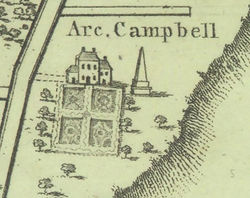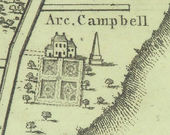Belmont (Baltimore, MD)
Overview
Alternate Names: Samuel Ready Female Orphan Asylum
Site Dates: c. 1778–c. 1936
Site Owner(s): Charles François Adrien le Paulmier, le Chevalier d’Annemours 1742–1809; Archibald Campbell 1747?–1805; James Hindman 1741–1830; James Carere; Thomas Tenant; David Barnum 1771?–1844; Zenus Barnum 1810–1865; Dr. Zenus Barnum 1854–1882; Samuel Ready Orphan Asylum;
Location: Baltimore, MD · 39° 18' 0.00" N, 76° 45' 0.00" W
Condition: Demolished
Other Resources: Getty TGN;
Belmont was a relatively modest country estate established around 1782 on the outskirts of Baltimore by Charles François Adrien le Paulmier, le Chevalier d’Annemours (1742–1809), Consul General of France for Virginia and Maryland. In addition to building a house and laying out gardens, D’Annemours erected America’s first monument in honor of Christopher Columbus at Belmont. Belmont later served as the site of the Samuel Ready Orphan Asylum.[1]
History
Having spent the majority of his life outside his native France, the Chevalier d’Annemours developed a greater affinity for the United States than for his homeland. When his career as French Consul General ended in 1793, he chose to remain in Baltimore—where he had served as an official representative of the French government from 1779 to 1793—rather than return to Paris. He retired to the two-story house he had built in approximately 1782 at Belmont, a 50-acre estate on “one of the most commanding sites in the suburbs of the city, overlooking a large part of the town, the Patapsco river, etc.”[2] The appearance of the house, now demolished, was documented in 1936 by photographs made by the Historic American Building Survey.[3] An impression of the surrounding landscape is provided by Charles Varlé’s Warner & Hanna’s Plan of the City and Environs of Baltimore, drawn in 1797, a year after D’Annemours sold Belmont to Archibald Campbell [Fig. 1]. Varlé represented a garden laid out in the geometric style, with parterres in circular and triangular formations. An orderly row of fruit trees flanks the garden on one side, complemented on the opposite side by a grove of more naturally dispersed trees.[4] An 1801 notice published in The Federal Gazette & Daily Advertiser gives credence to Varlé’s map, describing the estate’s “handsome grove of large lofty oaks, and . . . extensive kitchen garden and orchard, well stocked with fruit of the best and choicest kind” (view text). Portrayed on the map but unmentioned in the notice is the monument that D’Annemours erected in 1792 to commemorate the 300th anniversary of Christopher Columbus’s arrival in the New World. The monument took the form of a 44-and-a-half-foot high obelisk fashioned of brick covered with stucco, bearing the inscription “Sacred/to the/Memory/of/Chris. Columbus/Octob. XII/MDCC VIIIC.” The obelisk originally stood on an artificial mound in a grove of cedar and ash trees about 100 yards from D’Annemours’s house.[5]
After D’Annemours sold Belmont, the estate passed through several owners and gradually fell into decay. A writer describing Belmont’s condition in 1880 observed, “the grounds around the old mansion house, although sadly out of repair . . . , are still inviting and picturesque, with their box-wood walks, bordered roadways lined with rows of cedars, fine old fruit trees, and rosebush clusters here and there.”[6] Hidden by overgrown vegetation, the Columbus monument passed in and out of public awareness from the mid-19th century until 1964, when it was moved to its present location across the street from Herring Run Park on Harford Road in Baltimore.[7]
—Robyn Asleson
Texts
- Anonymous, August 17, 1792, Claypoole’s Daily Advertiser (quoted in Thompson 1906: 246)[8]
- “[The Chevalier d’Annemours built] an obelisk to honour the memory of that immortal man—Christopher Columbus . . . in a grove in one of the gardens of the villa . . . on the 3rd [sic] of August, 1792, the anniversary of the sailing of Columbus from Spain.”
- Hindman, James, January 1, 1801 (Federal Gazette & Daily Advertiser)
- “The subscriber offers for sale that handsome, elegant COUNTRY SEAT called Belmont, formerly the residence of Chevalier Danmour, beautifully situated within a mile and a half of the city of Baltimore, containing about 50 acres, well inclosed with good post and rail fences, and divided into lots of different sizes. . . . There is a handsome grove of large lofty oaks, and an extensive kitchen garden and orchard, well stocked with fruit of the best and choicest kind; likewise a large well constructed ice house, and two pumps (one of which is in the garden) that affords plenty of excellent water.” back up to History
Images
Notes
- ↑ J. M. Dickey offers a history of the site’s ownership, which becomes a bit muddled with the Barnum family, in Christopher Columbus and His Monument Columbia (Chicago and New York: Rand, McNally & Co., 1892), 78, view on Zotero. The estate was owned by David Barnum and seems to have descended to or been purchased by his nephew Zenus Barnum (who married David’s granddaughter, Anna), and thence to Zenus and Anna’s second-born son, Dr. Zenus Barnum. In his will, Dr. Barnum left much of his estate to his older brother, Francis, on the condition that he not become a Roman Catholic priest. Francis did so, causing the estate to revert to the Baltimore city council to fund the McDonogh School for Orphan Boys, the male equivalent of the Samuel Ready Female Orphan Asylum. See American and Commercial Daily Advertiser (May 1, 1848): 4; The Sun (June 18, 1870): 4; The Sun (July 13, 1883): 4; and Maryland, Its Resources, Industries, and Institutions (Baltimore: Sun Job Printing Office, 1893), 458, view on Zotero.
- ↑ Quotation from Samuel Ready Asylum Board report, c. 1887, in Robert S. Wolff, “Industrious Education and the Legacy of Samuel Ready, 1887–1920,” Maryland Historical Magazine (Fall 2000): 312, view on Zotero.
- ↑ See Library of Congress Prints and Photographs Online Catalogue.
- ↑ James D. Kornwolf, Architecture and Town Planning in Colonial North America, 3 vols. (Baltimore: The Johns Hopkins University Press, 2002), 2:752, view on Zotero.
- ↑ Herbert Adams and Henry Wood, Columbus and His Discovery of America, Johns Hopkins University Studies in Historical and Political Science, Tenth Series, vols. 10 and 11 (Baltimore: Johns Hopkins Press, 1892), 30, 70–71, view on Zotero.
- ↑ Article published in The American (Baltimore), November 19, 1880, quoted in Herbert Adams and Henry Wood, Columbus and His Discovery of America, Johns Hopkins University Studies in Historical and Political Science, Tenth Series, vols. 10 and 11(Baltimore: Johns Hopkins Press, 1892), 34, view on Zotero.
- ↑ Columbus Monument Papers (1898–1964), MS 1241, Maryland Historical Society.
- ↑ Henry F. Thompson, “The Chevalier D’Annemours,” Maryland Historical Magazine 1 (1906): 241–46, view on Zotero.


